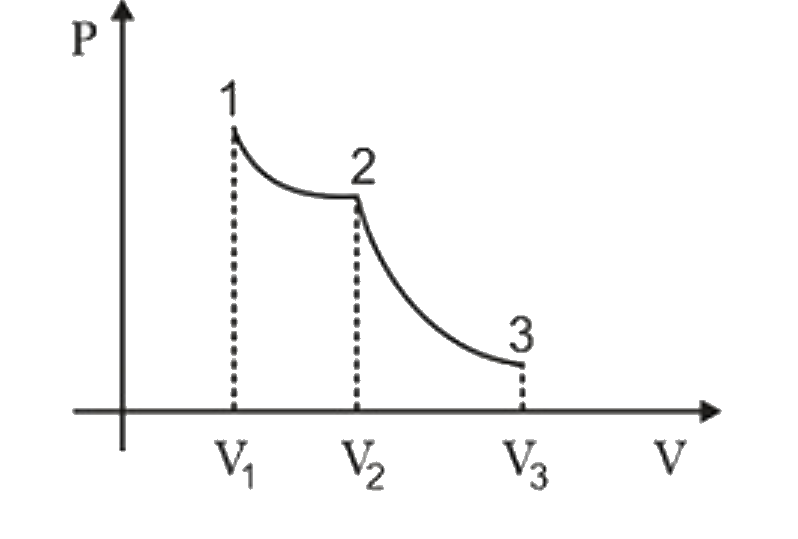Initial pressure and volume of a gas are P and V respectively. First its volume is expanded to 4V by isothermal process and then again its volume makes to be V by adiabatic process then its final pressure is (γ=1.5) -
8P
4P
P
2P
The correct Answer is:D
To solve the problem step by step, we will analyze the two processes: the isothermal expansion and the adiabatic compression.
Step 1: Isothermal Expansion
In the first step, the gas undergoes an isothermal expansion from volume V to 4V. For an isothermal process, we can use Boyle's Law, which states that the pressure of a gas is inversely proportional to its volume when the temperature is constant.
Using Boyle's Law:
P1V1=P2V2
Where:
- P1=P (initial pressure)
- V1=V (initial volume)
- P2 is the pressure after expansion
- V2=4V (final volume)
Substituting the values:
P⋅V=P2⋅4V
Dividing both sides by 4V:
P2=P4
Step 2: Adiabatic Compression
Next, the gas undergoes an adiabatic process where its volume changes from 4V back to V. For an adiabatic process, we use the relation:
P1Vγ1=P2Vγ2
Where:
- P1=P2=P4 (pressure after isothermal expansion)
- V1=4V (initial volume for adiabatic process)
- V2=V (final volume for adiabatic process)
- γ=1.5
Substituting the values into the adiabatic equation:
(P4)(4V)1.5=P3V1.5
Calculating (4V)1.5:
(4V)1.5=41.5V1.5=8V1.5
Now substituting this back into the equation:
(P4)⋅8V1.5=P3V1.5
Dividing both sides by V1.5:
P⋅84=P3
Simplifying:
P3=2P
Final Result
The final pressure P3 after both processes is:
P3=2P
In the first step, the gas undergoes an isothermal expansion from volume V to 4V. For an isothermal process, we can use Boyle's Law, which states that the pressure of a gas is inversely proportional to its volume when the temperature is constant.
P1V1=P2V2
Where:
- P1=P (initial pressure)
- V1=V (initial volume)
- P2 is the pressure after expansion
- V2=4V (final volume)
P⋅V=P2⋅4V
P2=P4
Next, the gas undergoes an adiabatic process where its volume changes from 4V back to V. For an adiabatic process, we use the relation:
P1Vγ1=P2Vγ2
Where:
- P1=P2=P4 (pressure after isothermal expansion)
- V1=4V (initial volume for adiabatic process)
- V2=V (final volume for adiabatic process)
- γ=1.5
(P4)(4V)1.5=P3V1.5
(4V)1.5=41.5V1.5=8V1.5
(P4)⋅8V1.5=P3V1.5
P⋅84=P3
P3=2P
The final pressure P3 after both processes is:
P3=2P
Topper's Solved these Questions
- BOOK - NEET PREVIOUS YEAR (YEARWISE + CHAPTERWISE)CHAPTER - NEETEXERCISE - PHYSICS157videos
NEET
- BOOK - NEET PREVIOUS YEAR (YEARWISE + CHAPTERWISE)CHAPTER - NEETEXERCISE - QUESTION95videos
NEET
- BOOK - NEET PREVIOUS YEAR (YEARWISE + CHAPTERWISE)CHAPTER - MOTION IN TWO AND THREE DIMENSIONEXERCISE - All Questions47videos
MOTION IN TWO AND THREE DIMENSION
- BOOK - NEET PREVIOUS YEAR (YEARWISE + CHAPTERWISE)CHAPTER - NEET 2020EXERCISE - All Questions45videos
NEET 2020
Similar Questions
One mole of perfect gas, initially at a pressure and temperture of 105Nm−2 and 300 K, respectively, expands isothermally until its volume is doubled and then adiabatically until its volume is again doubled. Find the final pressure of the gas. Given γ=1.4.
 View Solution
View SolutionThe pressure p and volume V of an ideal gas both increase in a process.
View Solution
Knowledge Check
- Question 1 - Select One
Initial pressure and volume of a gas are P and V respectively. First it is expanded isothermally to volume 4 V and then compressed adiabatically to volume V. The final pressure of gas will be (given γ=32)
A1PB2PC4PD8P - Question 2 - Select One
The pressure and volume of a gas are P and V. If its pressure is reduced to P/2, by (A) isothermal process (B) by adiabatic process then the final volume will be :
Amore in ABmore in BCequal in A and BDdepends on the nature of gas - Question 3 - Select One
An ideal gas of volume V and pressure P expands isothermally to volume 16 V and then compressed adiabatically to volume V . The final pressure of gas is [γ=1.5]
APB3PC4PD6P
The pressure P and volume V of an ideal gas both decreases in a process.
View SolutionA monatomic gas at a pressure P, having a volume V expands isothermally to a volume 2 V and then adiabatically to a volume 16 V. The final pressure of the gas is ( take γ=53)
View SolutionA monoatomic gas at a pressure P, having a volume V expands isothermally to a volume 2V and then adiabatically to a volume 16 V. The final pressure of the gas is (Take γ=5/3)
View SolutionFor an ideal gas with initial pressure and volume Pi and Vi, respectively, a reversible isothermal expansion happers, when its volume becomes V0. Then it is compressed to its original volume Viby a reversible adiabatic process. If the final pressure is Pf, then which of the following statement is true?
View SolutionThe initial volume and pressure of a gas are V and P respectively. It is expand by two different processes such that in each process the final volume becomes 2V. If the work done in isothermal change is W1 and the amount of work done in adiabatic change isW2, then
View Solution

